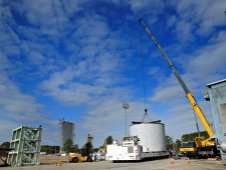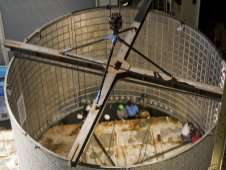The world's largest can crusher test

(PhysOrg.com) -- Place a soda can on the floor in an upright position and then stand on it -- gradually applying weight -- until the can ripples and collapses.
It's similar to what a team of NASA engineers will do to an immense aluminum-lithium rocket fuel tank in late March; their hope is to use data from the test to generate new "shell-buckling design factors" that will enable light-weight, safe and sturdy "skins" for future launch vehicles.
Testing for this innovative study is under way at NASA's Marshall Space Flight Center in Huntsville, Ala., where engineers are supporting the test led by the NASA Engineering and Safety Center, or NESC, based at NASA's Langley Research Center in Hampton, Va.
The aerospace industry’s shell buckling knockdown factors are a complex set of engineering data that dates back to Apollo-era studies of rocket structures -- well before modern composite materials, manufacturing processes and advanced computer modeling. The hope is for the new test data to update essential calculations that are typically a significant cost, performance, and safety driver in designing large structures like the main fuel tank of a future heavy-lift launch vehicle.
The large-scale test follows a series of smaller scale tests, all aimed at reducing the time and money spent designing and testing future rockets. And by incorporating more modern, lighter high-tech materials into the design and manufacturing process, rockets will save weight and carry more payload.

This week, technicians moved a 27.5-foot-diameter and 20-foot-tall space shuttle external tank barrel-shaped test article into place at Marshall's Engineering Test Laboratory. Once installed, the section will be sandwiched between two massive loading rings that will press down with almost one-million pounds of force on the central cylindrical test article forcing it to buckle.
"Spacecraft structures, especially fuel tanks, are designed to be as thin as possible, as every pound of vehicle structure sacrifices valuable payload weight and can dramatically increase the cost of flying a rocket," said Mark Hilburger, a senior research engineer in the Structural Mechanics and Concepts Branch at Langley and the principal investigator of the NESC's Shell Buckling Knockdown Factor project. "Looking toward future heavy-lifters, our goal is to provide designers greater confidence in how buckling happens in structures so we can develop lighter-weight tanks."
Research to date suggests a potential weight savings of as much as 20 percent.
Leading up to the big crush in late March, the shell buckling team has previously tested four, 8-foot-diameter aluminum-lithium cylinders to failure. In preparation for the upcoming test, hundreds of sensors have been placed on the barrel section to measure strain, local deformations and displacement. In addition, advanced optical measurement techniques will be used to monitor tiny deformations over the entire outer surface of the test article.
"This unique test rig was essential to developing the lightweight space shuttle external tank that is flying today. Our sophisticated testing capability is back in action to better understand design factors for next-generation metallic launch vehicle structures," said Mike Roberts, an engineer in Marshall’s Structural Strength Test branch and the center lead for this test activity. "Months of preparation for the facility, test article, high-speed cameras and data systems are all in place and ready to support this major test."
The Shell Buckling Knockdown Factor Project is led and funded by the NESC; Marshall is responsible for the test including the engineering, the equipment design, the hardware facilities and safety assurance. Lockheed Martin Space Systems Company fabricated the test article at Marshall's Advance Weld Process Development Facility using state of the art welding and inspection techniques.
Provided by JPL/NASA
















